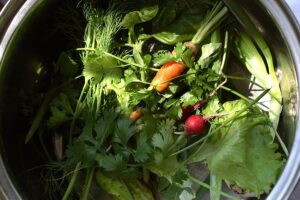 A kitchen garden is—as its name suggests–a garden that is as close to the kitchen as it can be. A kitchen garden provides the cook ingredients that are fresh-picked and at their peak of ripeness—fruits, vegetables, herbs, and edible flowers.
A kitchen garden is—as its name suggests–a garden that is as close to the kitchen as it can be. A kitchen garden provides the cook ingredients that are fresh-picked and at their peak of ripeness—fruits, vegetables, herbs, and edible flowers.
Plan to use the produce from your kitchen garden immediately, at the very next meal. And when the next meal is not your immediate concern, you can use the ingredients from your kitchen garden to put-up produce for out-of-season meals. The kitchen garden allows you to plan and easily accomplish meals throughout the year that are seasonally tasty.
Easy and quick access to the kitchen is a key consideration when choosing the site for your kitchen garden. The closer your kitchen garden is to the kitchen door, the easier it will be for you to quickly prepare and cook the freshest ingredients.
Kitchen garden location basics:
Here a few questions to consider:
• Where will a vegetable garden look best in your landscape?
• Does the location receive a minimum of 6 hours of full sun each day?
• Is there a water spigot or hose bib nearby?
• Will fences or hedges be needed to block the wind or keep out wildlife?
• Are there buried utility wires or pipes in the area? (Your utility company will come out and mark the location of underground utilities.)
Choosing your kitchen garden’s location:
• Sunlight. Vegetables require as much sunlight as they can get for the best growth. Avoid placing your kitchen garden in the shadows of trees, shrubs, walls, fences, or buildings. Trees and shrubs may compete with the vegetables in your garden for water and nutrients, as well.
• Water. Your garden will require water and should be located in an area that can be reached with a garden hose.
• Level ground. Select a location that is level and easy to prepare, plant, and water. If your location is on a slope, the best site for you kitchen garden would face south. You may need to terrace or run your crop rows across the slope to keep the soil from washing away.
• Good soil. You can improve almost any soil with the addition of organic matter and compos. If you have a choice, choose a site that drains well and where the soil looks good to you.
• Protection. Vegetables and fruit will grow best where they do not have to do battle with prevailing winds and grazing animals. A fence or hedge can shelter your kitchen garden from the wind and from wildlife. You should also plant vegetables away from low-lying areas where cold air and frost might linger.















